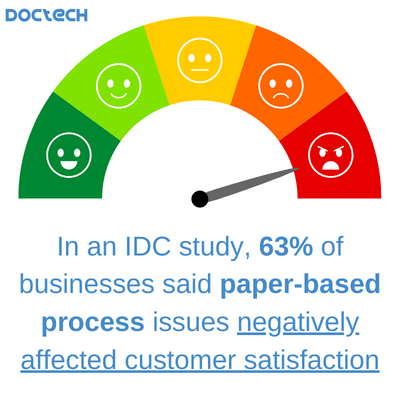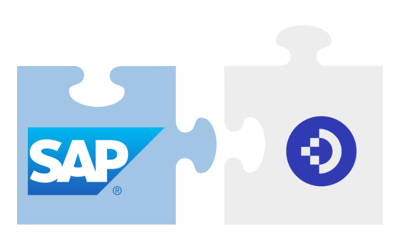Knowing when the time is right to enhance your ERP system with an electronic document management system can be quite challenging. Which system will take care of which process, how will the EDMS help, will they work together?! Choosing the right systems that will work for you business is time consuming, requires analysis and is a very important decision.
At DocTech we have the in-house expertise to integrate our document management software with a number of different ERP systems which provide a variety of benefits for our clients across numerous industries. The main purpose of this is to assist the data capture from documents and allow users to view documents instantly “within” the ERP system, saving a lot of time searching for supporting documentation.
 An electronic document management system (EDMS) is a software solution that digitally and securely stores scanned or emailed documents. Using inbuilt workflow tools, it provides a way to automate any business process associated with the stored documents such as invoice processing, purchase order management or employee onboarding.
An electronic document management system (EDMS) is a software solution that digitally and securely stores scanned or emailed documents. Using inbuilt workflow tools, it provides a way to automate any business process associated with the stored documents such as invoice processing, purchase order management or employee onboarding.
A main feature of an electronic document management system is the initial data capture of invoices as they are stored. Based on pre-defined criteria, the documents can be pushed for approval or to create tasks for users. The captured data can be transferred to the ERP system on a one by one basis or in bulk on schedules.
Once stored, documents are easy to find, cannot be lost or duplicated within the system. With digital documents there will NEVER be a need to print them out to give them an ERP attribution.
The acronym ERP stands for enterprise resource planning. The software manages day-to-day business activities, such as accounting, project management and manufacturing. It can use different applications that talk to each other and share a single database.
Information within an ERP system can arrive from many sources, such as invoices, credit notes, debit notes, delivery notes, salary info etc. This information comes from documents, whether they are paper or digital, and data on them must be exported, manually or via another app into the ERP. Without the existence of documents, the ERP wouldn’t work.
Some ERP systems can store some documents, but it is by no means the core functionality. ERP's mainly manage the data within them, not the actual documents themselves. Nor can they manage document approvals, document retention or provide an audit history.
Often there is little to no overview of the collective data held within the system. This makes it weak from a GDPR and efficiency point of view and can result in a lack of reporting ability.
 Businesses process huge numbers of documents that contain relevant and important information that isn’t fed into an ERP. Items such as technical manuals, excel reports, photos, videos, and audio files.
Businesses process huge numbers of documents that contain relevant and important information that isn’t fed into an ERP. Items such as technical manuals, excel reports, photos, videos, and audio files.
These documents must be searchable at any time which makes a separate EDMS so valuable, as ERP related documents are a small subset of the documents being managed by a business.
When businesses add an EDMS to their systems, they get a digital archive they can utilise for a manner of processes aside from those relating to ERP based processes.
Documents related to ERP activities such as invoices, delivery notes or packing slips can also be stored in the EDMS and the advantage our software has, is that it can sit ‘within’ you core application. EDMS integration with an ERP has become invaluable for many of our clients because once documents are securely stored in the document management system, they are immediately available for any ERP requirement, such as recalling an invoice linked to an ERP record.
Business documents have multiple places of creation and receipt, either being produced internally, received or sent via email, from an ERP, or a CRM system etc. When documents are left in their original place, employees need to search across multiple locations to find the information they require.
When all documents are stored in an electronic document management system, they can be found by a user instantly, regardless of their format, due to the way they are tagged, indexed and organised within the system. A document management system and ERP system can work so well together as documents can be accessed directly “within” the ERP system with no need to perform searches.
If your organisation already has an ERP system, you’ll be taking advantage of the huge benefits it brings. Integrate it with an electronic document management system and employees will gain more control over their work and have more time to complete everyday tasks. The information they require is quickly accessible, available to them without leaving the ERP, and there is no need to manually enter data from invoices in to the ERP system. An integrated button means with a click, related documents stored in the EDMS are instantly accessible within the ERP.
This is in addition to knowing all your documents are secure and compliant. A good EDMS should complement your current ERP, making the functionality of both systems central to all business processes.
If you’d like to know about the additional functionality an electronic document management system cam add to your ERP, let us show you - get in touch on 0161 667 3390 or info@doctech.co.uk.
As organisations are now predominately conducting business online, manual and paper finance processes will struggle to keep up. Traditional ways of working no longer fit into fast paced, modern workplaces and organisations ...
We all have very busy lives. With both work and personal commitments, we often feel like there are not enough hours in the day to achieve everything we want to achieve. This can leave us all feeling a little deflated when ...
Machine learning in finance improves processes by automating tasks and reducing errors through the use of data algorithms that improve in accuracy as time goes on.